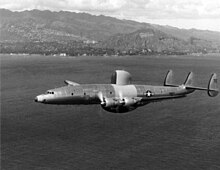| EC-121 Warning Star | |
|---|---|
 EC-121T Warning Star | |
| General information | |
| Type | Airborne early warning and control |
| National origin | United States |
| Manufacturer | Lockheed Corporation |
| Primary user | United States Navy, United States Air Force |
| Number built | 232 |
| History | |
| Manufactured | 1953–1958 |
| Introduction date | 1954 |
| First flight | 9 June 1949 |
| Retired | 1978 (USAF) 1982 (USN) |
| Developed from | L-749 Constellation L-1049 Super Constellation C-121 Constellation |


The Lockheed EC-121 Warning Star is an American airborne early warning and control radar surveillance aircraft operational in the 1950s in both the United States Navy (USN) and United States Air Force (USAF).
The military version of the Lockheed L-1049 Super Constellation was used to serve as an airborne early warning system to supplement the Distant Early Warning Line, using two large radomes (a vertical dome above and a horizontal one below the fuselage). It replaced the TBM-3W used by the USN. Some EC-121s were also used for signal intelligence gathering. The EC-121 was introduced in 1954 and phased out in 1978, although a single specially modified EW aircraft remained in USN service until 1982.
The USN versions when initially procured were designated WV-1 (PO-1W), WV-2, and WV-3. The USAF Warning Stars served during the Vietnam War both as electronic sensor monitors and as a forerunner to the Boeing E-3 Sentry AWACS. USAF aircrews adopted its civil nickname, "Connie" (diminutive of Constellation) as reference, USN aircrews used the nickname "Willie Victor".